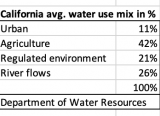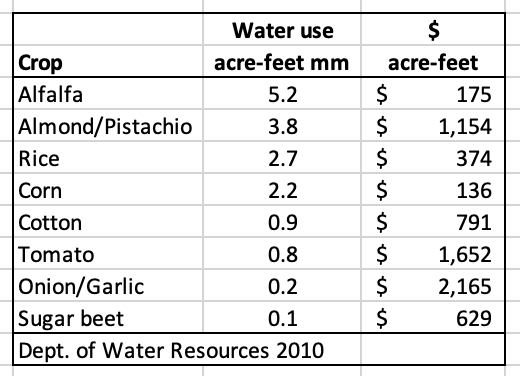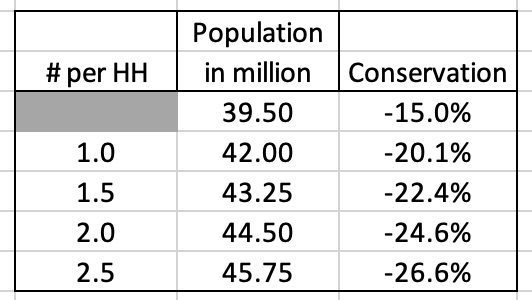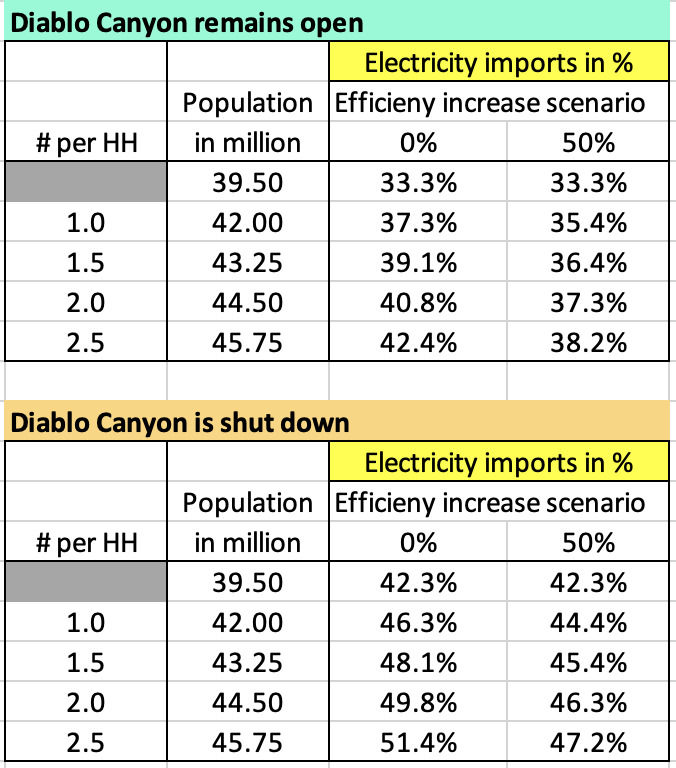Blog Post < Previous | Next >

Guy
Is California "Collapsing"?
I use Jared Diamond’s concept of "Collapse" as defined in his bestseller.
Within this book, Diamond states that societies collapse because of eight systemic failures. And, two of the main ones are:
- Mismanage population growth; and
- Mismanage water resources.
Sacramento is attempting to boost California’s population from about 40 million to close to 46 million by 2031 by mandating the State build 2.5 million residential household units by that date. In estimating the 6 million population increase, I am assuming 2.5 individuals per household which is low compared to recent figures (see graph below).
At the same time, California is experiencing a self-inflicted ongoing water crisis.
In addition to Diamonds’ eight collapsing factors, California is experiencing additional systems’ vulnerabilities including electricity supply, and transportation infrastructure.
We will focus on several of these prospective system challenges. Let’s start with population.
Population
The California State Government can’t reach a consensus on population forecast. Two State agencies are at odds with each other:
- The California Department of Finance Demographics Research Unit (DRU) forecasts that California’s population will remain flat till 2060; and
- The California Department of Housing and Community Development (HCD), as indicated anticipates California’s population will grow rapidly.
The California DRU forecast
It forecasts that California’s population will remain pretty much flat out to 2060. And, even so the DRU’s projections are optimistic. They used a migration (into the State) assumption close to its 75th percentile during the history of the data (2009–2022). Using a more realistic assumption at the 50th percentile, you get that California’s population will decrease by 2060.
The graph above shows that the DRU projects that by 2060, California’s population will be 39.5 million. Projections using the 50th percentile migration level come in at 1.1 million less, or 38.4 million.
Later, I found a longer time series on the California demographic growth components. It highlights how optimistic the DRU migration forecast is.
The graph above shows that the DRU projected migration rates would rebound quickly after 2022 to near the record level of around 0.20% that occurred in 2011 and 2012. And, it remains at near 0.20% till 2060. Meanwhile, the actual migration rate was negative the majority of the time even before COVID & Work From Home (WFH). During that period (COVID & WFH), the migration rate cratered to record negative levels.
California’s migration rate is unlikely to bounce back to near-record levels for several reasons.
- The first one is that all its migration — feeders, other States, and other countries are experiencing their own demographic aging. And, they will send fewer migrants to California.
- The second reason is because of deglobalization, fewer migrants from other countries have access to California.
- The third reason is because of WFH, fewer individuals will need to move to California to have access to high-paying hi-tech jobs.
Moving on to California's natural growth rate, the DRU projections capture California's demographic aging. The DRU expects this growth rate to continue declining and turn increasingly negative by 2035 and thereafter.
The California HCD projections
To understand how divergent the HCD projections are, we need a bit of history. The DRU’s earlier projections in July 2021 estimated that California’s population would increase by over 5 million by 2060. At the time, the DRU did not have the data to capture COVID and WFH. In July 2023, DRU updated its forecast and instead estimated that California’s population would remain pretty much flat out to 2060.
Despite DRU’s reducing its population growth forecast from 5 million down to Zero out to 2060, HCD has refused to decrease its mandate of building 2.5 million residential units by 2031. It is unclear what actual population growth HCD is targeting. But, even assuming there would be only the bare minimum of 1 individual per household, this still entails that HCD expects California’s population to increase by 2.5 million by 2031.
So, who is winning? the DRU or HCD?
It is clearly the HCD. The latter and the entire Californian Governance have disregarded the DRU projections anchored in demographic realities.
Next, let’s move on to California's water scarcity.
Water
On average agriculture uses 42% of California’s water. Human beings (urban sector) use only 11%, and the environment accounts for the other 47%. You can see more details in the table below.
Within both the regulated environment water release and agriculture sectors there are enormous water mismanagement issues.
Regulated environment water release
During this past Winter when California had abundant rainfall, it had to release a good deal of its water to maintain an endangered small fish, the delta smelt. You can read about it in the article below:
California stormwater storage limited by 2-inch fish
If this article is behind a paywall, I copied the first three paragraphs that convey the key information.
“The most drenching storms in the past five years have soaked northern California, sending billions of gallons of water pouring across the state.
But 94% of the water that has flowed since New Year’s Eve through the Sacramento-San Joaquin River Delta, a linchpin of California’s water system, has continued straight to the Pacific Ocean instead of being captured and stored in the state’s reservoirs.
Environmental regulations aimed at protecting a 2-inch-long fish, the endangered delta smelt, have required the massive state and federal pumps near Tracy to reduce pumping rates by nearly half of their full limit, sharply curbing the amount of water that can be saved for farms and cities.”
I read in other sources that scientists could count only five smelts. Between five smelt and 39.5 million Californians, the five smelt win.
Agriculture
California agriculture wastes an enormous amount of water on cheap very water-intensive crops including alfalfa, rice, corn, and cotton (see table below).
The data from the Department of Water Resources is quite outdated (2010). But, that is the last data available. However, it is hopefully still representative. Notice there is a strong negative relationship between crop water use and crop value (correlation — 0.53). That does not make economic sense.
The water use on low-value crops is humongous. One acre-feet of water can support close to 11 individuals for a year who use 83 gallons per day (Californians’ average). So, the 5.2 million acre-feet of water used to grow alfalfa could support 56 million additional Californians!
When California exports food it essentially exports water. And, that is water it desperately needs to sustain its own civilization.
Agriculture accounts for only for 2.5% of California’s GDP (2021 data from the University of Arkansas Division of Agriculture). Yet, it accounts for 42% of overall State water use and about 80% of it if you exclude the environment.
The future of California agriculture will become increasingly constrained. This is because California draws 4.4 million acre-feet from the Colorado River. The six other States that are part of the Colorado River Compact are disputing that California can keep on draining that much from the Colorado River.
Urban, human water allocation
The fisheries and agriculture come way ahead in terms of water allocation priority. Both sectors are associated with unsustainable inefficiencies.
Gavin Newsom has stated a goal to boost human water conservation by 15% over current levels. However, he is the same Governor who is ignoring demographic realities and pushing to build 2.5 million residential units by 2031.
It is not clear how many individuals the HCD associates with their goal of adding 2.5 million residential units by 2031. Let’s run scenarios associated with different ranges of individuals per household (from 1 up to 2.5 individuals per household).
As the population increases, the resulting conservation goal has to increase from — 15% to — 26.7% just to maintain the same overall water consumption.
Electricity
California generates only about 2/3ds of the electricity it uses. It imports the remaining third from other Western States.
Even if California's population does not increase as projected by the DRU, California imports are likely to rise as a % of total electricity generated in California. This is because of California’s efforts to lead the electrification revolution. This includes California mandating to not sell any gas-powered car within the State by 2035 and also eliminating gas stoves in any new home development. Also, the Diablo Canyon nuclear plant is scheduled to be decommissioned by 2030. And, it generates 9% of the electricity in the State.
How much electricity imports could increase given different population growth scenarios?
Let’s discount the huge electrification efforts, and just focus on the prospective population growth scenarios associated with the HCD adding 2.5 million residential units by 2031. Now, let’s contemplate how the imported electricity % increases as the population increases. We will look at two scenarios. The first one assumes no increase in electricity consumption efficiency. So, electricity consumed is proportional to the population level. The second scenario assumes a very high increase in electricity consumption efficiency of 50%. In this case, electricity consumed rises by only half as much as the population increases. We will also look at scenarios assuming the Diablo Canyon plant keeps on running, and another set of scenarios with the Diablo Canyon plant shut down. See the resulting increase in California electricity imports as % of total electricity generated.
If California was successful in raising its population between 2.5 and 6.25 million, it would result in massive increase in California electricity imports even assuming incredibly high improvement in efficiency. And, the above is grossly underestimated as it does not factor the mentioned electrification measures. The above suggests several important considerations:
- Can California afford to shut down Diablo Canyon and maintain an adequate electricity generation?
- Does the West Coast generate enough surplus electricity for California to import up to half of its electricity?
- How feasible is California’s electrification revolution?
Transportation
Public transportation is facing enormous fiscal challenges. WFH has caused public transport ridership to plummet. Public transport will need additional Government subsidies at a time when California is already incurring substantial fiscal stress.
The road infrastructure is facing its own challenges. The advent of EVs will cause a reduction in gas tax receipts and an increase in road deterioration (EVs are heavier). As a result, the State’s road infrastructure will get more fragile going forward.
Getting back to HCD, it plans for high density housing often associated with inadequate parking space. Without adequate public transportation and ability to own and park a car where one lives, the residents will be challenged to earn a living. WFH will avail only a small minority of the new apartment bound individuals with a job. The majority will either need a car or access to good public transportation to have a job. When missing both, individuals will just not move in such high density developments.
Conclusion
We need a California Government who thinks coherently across several different systems (population, water, electricity, transport). A Government hell bent on dramatically boosting population growth while suffering chronic water supply shortages due to grossly mismanaging natural water resources and agriculture is a recipe for “collapsing.”
Hopefully, demographic forces will prevail (they usually do). California’s social engineering experiment in mandated population growth will fail. And, as a result California will only suffer a rental housing Bubble-and-Crash (you can read more on the subject within the following article).
Sacramento is creating an inevitable apartment Housing Bubble
This would be better than running out of water and electricity faster due to mismanaged population growth.









